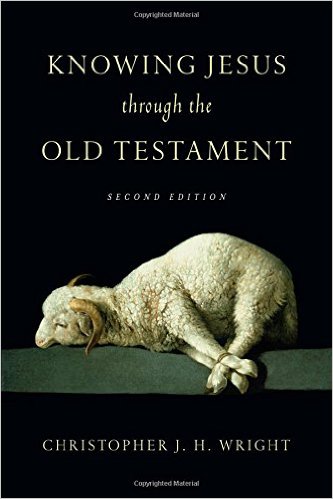 Incredibly deep. Amazingly broad. Intriguingly specific. Beautifully informative. Boldly daring. These are just some of the phrases that came to mind when I recently read Knowing Jesus Through the Old Testament by Christopher J. H. Wright (InterVarsity Press, 2014). Frankly, what I was expecting was a simple rehashing of typical Old Testament types and prophecies, with their fulfillment neatly correlated and documented. Instead, Knowing Jesus Through the Old Testament was—and is—a rich historical and theological treatise on the person of Jesus Christ in six main chapters. In fact, Knowing Jesus Through the Old Testament is one of the most inspiring and informative books I’ve read in recent years. What a delight to digest!
Incredibly deep. Amazingly broad. Intriguingly specific. Beautifully informative. Boldly daring. These are just some of the phrases that came to mind when I recently read Knowing Jesus Through the Old Testament by Christopher J. H. Wright (InterVarsity Press, 2014). Frankly, what I was expecting was a simple rehashing of typical Old Testament types and prophecies, with their fulfillment neatly correlated and documented. Instead, Knowing Jesus Through the Old Testament was—and is—a rich historical and theological treatise on the person of Jesus Christ in six main chapters. In fact, Knowing Jesus Through the Old Testament is one of the most inspiring and informative books I’ve read in recent years. What a delight to digest!
That’s why I’m doing a chapter by chapter summary/review here at InkLink over the next several weeks—to share my own highlights in hopes you’ll be prodded to read it as well. In fact, pick up a copy this week and read it in tandem with these periodic reviews. I think you’ll find it to be a rewarding summer read.
Chapter One: Jesus and the Old Testament Story
In describing the story of Jesus, Wright appropriately goes back to Abraham, using Matthew 1 to trace the line forward all the way to the time after the exile (i.e., the intertestamental period). This tracing involves three distinct characters—Abraham, David, and Jesus—as well as one distinct event—the Babylonian Exile.
In doing this, Wright brings attention to the need to read the first 17 verses of Matthew 1, not just the ones after verse 17. He effectively shows the story of the man Jesus, proving Jesus was who he said he was in real time and space.
Additionally, Wright explains who Jesus the man was/is in five interesting ways, and then gives necessary information on the three phases described in Matthew 1:1-17. Furthermore, Wright explains much about the various time periods involved in these three phases, with essential but limited facts from history included. This kind of record, one that shows the beginning and the end, is just one way Wright shows that what “God had been doing through no other nation he now completed through no other person than the Messiah.”[1]
In highlighting this aspect, I especially appreciated the way Wright showed the paradox involved in this narrowing down of redemption’s work to the “unique particularity of the single man, Jesus.”[2] In fact, this is how he wraps up chapter one, showing how God’s story through Israel is actually God’s story to the whole world. As he so says, “one story, one people.”[3]
Much in this chapter made me reflect on another book I read this year during Passion Week, The Man Christ Jesus: Theological Reflections on the Humanity of Christ by Bruce Ware (Crossway, 2012). Ware’s work showcased the necessity of the man, Jesus, and, combined with my own study and preaching through Hebrews at the time, that book was very instrumental in my personal sanctification.
I found much the same effect happening all over again as I started Wright’s book. His focus on Jesus the man, and the need for him, as the second person of the Trinity, to be and do exactly what he was and did, deepened further still my understanding of his walk and work. The Apostle Paul was spot-on when he wrote to Timothy, “For there is one God, and there is one mediator between God and men, the man Christ Jesus” (1 Timothy 2:5, English Standard Version).
Furthermore, to realize that the story of this “one mediator” begins in the Old Testament is the kind of awakening that helps us see the Bible as a whole connected story, not as two disconnected parts. So often in church life we separate the Testaments, and, unintentionally and unfortunately, divide the story for people in a way that keeps them, not complementary, but sometimes almost competing. Wright’s first chapter helped me see the importance of combatting that tendency by continuing to preach Jesus from every part of the Bible, showing him as central to every section and theme.
He did this best when he challenged me, the reader, to not begin Jesus’ story in Matthew 1:18. Instead, begin at the beginning (novel thought, eh?), and see the value and importance of the genealogies. That is, essentially, the Old Testament, and that’s where Jesus Christ’s story begins. As short and almost humorous as Wright’s pointed paragraph was when he “called us out” on our selective reading, I thought this was a fabulous way of getting to the heart of the problem while at the same time highlighting the very thing we too often overlook: the first 17 verses of Matthew 1.
[1] Christopher J.H. Wright, Knowing Jesus Through the Old Testament (Grand Rapids, Michigan: 2014), 53.
[2] Ibid.
[3] Ibid, 61.

4 Comments on “Summer Book Review: “Knowing Jesus” [Ch. 1]”
Pingback: Summer Book Review: “Knowing Jesus” [Ch. 3] |
Pingback: Summer Book Review: “Knowing Jesus” [Ch. 5] |
Pingback: Summer Book Review: “Knowing Jesus” [Ch. 6] |
Pingback: The Massacre of Bethlehem Boys and Matthew’s Message of Hope |